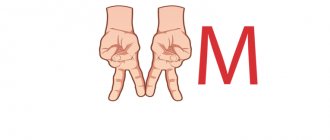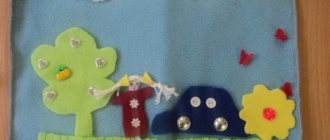Preparatory group. Senior preschool age. Children 6-7 years old
Literacy lesson in the preparatory group “Sounds [K[-[K'] and the letter K”
Goals and objectives: Educational: Clarify the articulation of sounds (K-K)
;
exercise the ability to divide words into syllables , conduct sound analysis ; develop phonemic hearing; make sentences with the preposition to; introduce the letter Kk ; consolidate images of letters .
Developmental:... Summary of a lesson on teaching literacy and ecology in the preparatory group “A Journey to the Forest for Good Deeds” Prepared by teacher: Khromogina L. N. 2022 Summary of a lesson on teaching literacy + ecology in the preparatory group “A Journey to the Forest for Good Deeds”
.
Program content : Educational: - consolidate the correct, clear pronunciation of the sound [B] in syllables , words,...
Goal: to increase the competence of teachers in the theoretical issue of preparing children for literacy.
Tasks:
- systematize teachers’ knowledge of basic concepts in the field of literacy education;
- to clarify and systematize teachers’ knowledge of methods for conducting educational activities for teaching children to read and write.
Plan:
- The concept of "preparing for literacy", tasks.
- Basic terms.
- Sound analysis of words.
- Structure of literacy preparation lessons.
Dear teachers! I am glad to welcome you to our logo hour. One of the main tasks of preschool educational institutions is to prepare children for school. This task includes, in particular, preparation for learning to read and write – reading, basic writing skills. Let's first define what we mean by the concept of “literacy”? (teachers' answers)
Literacy is the basic rules for reading and writing texts in a certain language.
Learning to read and write is mastering the ability to read and write texts, express one’s thoughts in writing, and understand when reading not only the meaning of individual words and sentences, but also the meaning of the text, i.e. mastery of written language. A student of literacy learns to translate speech sounds into letters, i.e. write and recreate sounds by letter, i.e. read.
Based on this definition, I believe it is correct to use the term “preparing for literacy.”
Children comprehend a certain system of their native language, learn to hear sounds, distinguish between vowels and consonants (soft, hard), compare words by sound, divide words into syllables, make words from chips, etc. Later, children learn to divide the speech stream into sentences, sentences into words, become familiar with the letters of the Russian alphabet, compose words and sentences from them, using grammatical rules of writing, and master syllable-by-syllable and continuous reading methods. However, learning to read is not an end in itself. This task is solved in a broad speech context, children acquire a certain orientation in the sound reality of their native language, and the foundation for future literacy is laid.
Issues for discussion:
- What do you think includes preparing children for literacy? (development of phonemic processes, teaching initial reading, typing letters, work on speech development, preparing the hand for writing)
- Why do you think it is necessary to teach children to read in kindergarten and is it necessary to do it at all? (Children are interested, it will be easier to study, parents’ request.)
So, from the above we can conclude: the tasks implemented on the GCD in the process of preparing for literacy training can be formulated as follows:
- introduce children to the concepts of “sound”, “syllable”, “word”, “sentence”;
- introduce preschoolers to the basic properties of the phonemic (sound) structure of a word;
- introduce children to models (schemes) of words and sentences, special symbols to indicate sounds;
- teach children to name and select words denoting the names of objects, actions, and characteristics of an object;
- teach children to compare sounds according to their qualitative characteristics (vowels, hard and soft consonants, voiceless and voiced consonants), to compare words according to their sound composition;
- teach children the syllabic division of words, the isolation of syllables from a word, the placement of stress in words, the definition of a stressed syllable;
- to teach how to distinguish words in a sentence by ear, determine their number and sequence, and compose sentences, including those with a given number of words.
Thus, a child’s readiness to learn to read and write consists of many components, among which primary importance is given to such speech characteristics as developed speech hearing (it underlies the prevention of dysgraphia and dyslexia), clear articulation of the sounds of the native language (which ensures correct pronunciation), knowledge visual images of sounds (letters) and the ability to correlate sounds with letters; developing flexibility and accuracy of hand movement, eye, sense of rhythm (which is especially important for mastering writing).
When teaching literacy, it is necessary to form in children basic concepts such as “word”, “syllable”, “sentence”, “vowel sound”, “consonant sound”, “hard sound”, “soft sound”, “letter”.
Let's understand these concepts.
Issues for discussion:
- What is the difference between a sound and a letter?

- What sounds are called vowels? (when pronounced, the air stream does not encounter obstacles; vowel sounds can be sung)
- How many vowel sounds? Name them. (A, O, U, I, S, E)
- What sounds are called consonants? (during the pronunciation of which the air stream encounters obstacles: tongue, teeth or lips; consonant sounds cannot be sung).
- Which consonants are always hard? (W, F, C) Always soft? (Y, Shch, Ch).
- What is a syllable? (A sound or combination of sounds in a word, pronounced with one impulse of exhaled air).
- What is an offer? (this is a unit of language that is a grammatically organized combination of words (or a word) that has semantic and intonation completeness. From the point of view of punctuation, a sentence as a complete unit of speech is formed at the end with a period, exclamation or question marks - or an ellipsis).
In GCD in preparation for learning to read and write, the child must master the skills of sound analysis. ONLY THE SOUNDING WORD is given for analysis! When identifying sounds in a word, the child should rely on the spoken word, and not on the written word. Some of the children know letters or are already reading, therefore, there is confusion in the concepts of sound and letter.
When improving sound analysis skills, it is necessary to follow the order of formation of mental actions:
- based on material resources (visuality, handouts, chips, etc.);
- in speech terms (pronunciation);
- according to the idea - in the mind (the most difficult thing).
Sequences of presentation of words for sound analysis:
words with two vowels (au, ua); words made of two sounds (um, ah, us); words of three sounds (smoke, peace); words of two open syllables (vase, mom); words of one syllable with a consonant cluster at the end (bush, leaf); words of one syllable with a combination of consonants at the beginning (yard, thunder); words of two syllables with a consonant cluster at the junction of syllables (daw, bag); words of three open syllables (Larissa, work).
Submission for sound analysis of words whose spelling does not differ from their pronunciation.
The word analysis should be carried out in a certain sequence:
- Say the word and listen to it. Before the isolation of sounds from a word begins, the speech therapist must make sure that the child pronounces the word correctly.
- Say the word syllable by syllable.
- Highlight (stretch out) the first sound in the word, name it, describe it.
- Indicate the selected sound with a token.
- Stretch (highlight) the second sound in the word, characterize it.
- Third sound, etc.
- Read the whole word from the chips.
- Answer the questions: - how many sounds are there in a word? - how many vowels? - how many syllables? - how many consonants?
Let's consider the organization of plot-thematic periods of GCD:
1. Organizational moment.
The purpose of the organizational moment: to introduce the topic of the lesson, create a positive attitude towards learning, awaken interest in learning new sounds, and also carry out correction of psychophysical functions. The main task of the teacher is to include children in the work from the first minutes of class. The exercises are carried out in different ways, but in any case it is useful to include relaxation, facial expression and imitation exercises. For example, a lesson based on the plot “A Walk in the Forest” begins with a riddle: “The sun is baking, the linden tree is blooming, the rye is ripe, when does this happen?” Imagine that it is summer now. Raise your hands to the sun, turn your face. You feel warm and pleasant (relaxation). The sun hid. Hunch into a ball - cold (tension). The sun was shining again (relaxation).
2. Repetition of the material covered.
Goal: to update children's knowledge. Repetition is carried out in a playful way, for example playing with a ball. These can be games to distinguish between the concepts “sound” - “word”, “vowel sound” - “consonant sound”, recalling words with a given sound, etc.
3. Post a new topic.
Goal: to direct children’s attention to the sound being studied, to the perception of new and repetition of sounds they have learned. In a playful way, through a problem situation, children, under the guidance of a teacher, determine a new sound.
4. Characteristics of sounds according to articulatory and acoustic characteristics.
Goal: to train children to analyze sounds according to acoustic and articulatory characteristics.
At this stage the following tasks are implemented:
- clarification of articulation - the position of the lips, tongue and teeth when pronouncing the sound being studied;
- the acoustic characteristics of sounds are specified: vowel - consonant, soft consonant - hard, voiced - unvoiced;
- sounds are indicated by colored symbols.
5. Consolidation of new material.
Goal: develop phonemic processes, improve sound analysis skills. Children are offered games to isolate sounds from a number of sounds, syllables, words, sentences; determining the first and last sound in words, determining the position of a sound in a word, naming words based on a given sound, selecting pictures with a given sound, differentiating soft and hard consonant sounds. The sound analysis of a word is first carried out jointly with the teacher, then independently by the children, then you can offer to select words to a given pattern.
6. Physical exercise.
The physical minute is closely related to the topic of the lesson and is a transition point to the next part of the lesson. The main objectives of physical training are: - to relieve fatigue and tension; — in introducing an emotional charge; - improving gross motor skills; - in the development of clear coordinated movements in conjunction with speech.
7. Introducing the letter.
Goal: to determine the connection between sound and its graphic image. Introducing letters begins with children being shown capital and lowercase printed letters. Children look for it at the cash register, feel the plastic letter with their fingers, trace it, and shade it. Lowercase and uppercase letters are compared. Similarities and differences are noted. Determine what the letter looks like. You can suggest making a letter from plasticine, laying it out from buttons, sticks, cereals, drawing a letter on semolina, showing the letter with your hands and body.
8. Development of reading and typing skills.
Goal: improve syllabic reading skills. Syllables and words with only learned letters are read: from simple at the beginning of the school year to more complex at the end. It is imperative to work with the split alphabet so that children can develop a conscious perception of the syllables and words they are composing. A wide variety of gaming techniques are used: insert the missing letter, the letters (syllables) are mixed up, replace one letter with another, what word do you get?
9. Summary. The lesson is summarized. The teacher asks the children what new they learned during the lesson, what games they played, what was difficult, etc.
To consolidate your knowledge, I suggest you take part in a mini-quiz. You will divide into 2 teams and complete the proposed tasks.
Task 1 – for the team “Curious”
What is the difference between a sound and a letter? Always name soft consonant sounds. Draw the letters C, X, U, B with your hands. Name the number of letters in the word money. Divide the word hairdresser into syllables. Change the word according to the example: many houses - one house, many cuffs - (one cuff). Name words related to the word “game”. Name the first sound in the words rook, brush, apple, stump, clouds. How many words are there in a sentence: Autumn has come and migratory birds have flown south.
Task 2 – for the team “Curious” Perform a sound analysis of the word and select other words for this scheme. Kalina
Task 2a - for the “Know-It-Yours” team Select words similar to sound analysis. poppy, soap, flies, cloud, net, fox, shovel, stove, raspberry, garden.
Task 3 – for the team “Curious” Restore the text. A hedgehog runs across the forest and across the clearing. Autumn there is little production of hedgehogs. The marmots and lizards hid. The circles curled up like the thin make-up. Labor but found bugs.
Task 1 – for the “Gramoteyki” team
What is the difference between a consonant and a vowel? Always name hard consonant sounds. Draw the letters G, T, Ch, M with your hands. Name the number of sounds in the word anchor. How many syllables are in the word electricity? Continue the series: lion - lion cub, monkey - (baby monkey). Name words related to the word “sound”. Name the last sound in the words oven, earth, pillar, laziness, loud. How many words are in a sentence: Every morning, sparrows chirp cheerfully outside my window.
Task 2 – for the “Gramoteyki” team Perform a sound analysis of the word and select other words for this scheme. Cap
Task 2 a - for the “Gramoteyki” team Select words that are similar for sound analysis. whale, saw, rooster, window, skating rink, milk, book, rainbow, meadow, bandage.
Task 3 - for the team “Curious” Night in the afternoon dragging in the room softly, souls of the leaves. When de tzim. The snow covers the hole and the snowdrift. The fluffy ones made it warm. Will be sleeping with us again.
This concludes our meeting. Goodbye.




